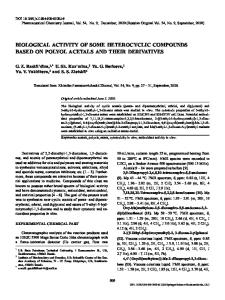Acyclic Enaminodiones in the Synthesis of Heterocyclic Compounds
- PDF / 672,481 Bytes
- 13 Pages / 594 x 792 pts Page_size
- 45 Downloads / 304 Views
REVIEWS
Acyclic enaminodiones in the synthesis of heterocyclic compounds Dmitrii L. Obydennov1*, Elena V. Chernyshova1, Vyacheslav Ya. Sosnovskikh1 1
Institute of Natural Sciences and Mathematics of Ural Federal University, 51 Lenina Ave., Yekaterinburg 620000, Russia; е-mail: [email protected]
Submitted March 9, 2020 Accepted after revision May 8, 2020
Translated from Khimiya Geterotsiklicheskikh Soedinenii, 2020, 56(10), 1241–1253
O R1
Heterocycles and carbocycles Regioselectivity Domino reactions R2 Natural compounds Me Modern inhibitors of HIV integrase N Dolutegravir, cabotegravir, bictegravir, Me ciprofloxacin, ivacaftor O
This review examines current trends in the use of readily accessible acyclic enaminodiones in the synthesis of heterocyclic structures, including medicinal and natural compounds. Enaminodiones are latent tricarbonyl compounds, therefore their synthetic use exploits mainly their electrophilic properties. In addition, they can act as C-nucleophiles and participate in formal (4+2) cycloaddition reactions as ambiphilic reagents, as well as key intermediates in intramolecular cyclizations. The review analyzes the literature published in 2012– 2019; the systematization is based on the structure of the formed heterocycle. The bibliography of the review includes 97 sources. Keywords: chromone, enaminodione, isoxazole, pyrazole, 2-pyridone, 4-pyridone, pyrimidine, 4-pyrone, pyrrole, 4-quinolone, ambiphilicity, heterocyclization, carbocyclization.
In recent years, more and more attention has been paid in the literature to acyclic 2-[(dimethylamino)methylene]1,3-dicarbonyl compounds (hereinafter referred to as enaminodiones), which include enamino diketones, enaminoketoamides, and enaminoketo esters, as highly active building blocks with versatile reactivity for the construction of various bioactive cyclic systems. Due to the pronounced push-pull character of the C=C bond, which is provided by two carbonyl groups and an amino group in conjugation, these enamines are more electrophilic substrates than β-aminovinyl ketones (enaminones). The most active electrophilic center in enaminodiones is the sterically unhindered β-position of the C=C bond, from which the initial reaction with various nucleophiles begins, proceeding as the Michael reaction followed by the elimination of the dimethylamino group. Enaminodiones are commonly used as 1,3-dielectrophiles for the preparation of five- and six-membered heterocyclic compounds, but their synthetic potential is not limited to this. Thus, in the presence of an active methylene group or other nucleophilic center, these substrates become * Here and further the corresponding author is marked with *. 0009-3122/20/56(10)-1241©2020 Springer Science+Business Media, LLC
nucleophilic or ambiphilic reagents, which significantly expands the possibilities of their use in various chemo- and regioselective cyclizations. It is important to note that in reviews on enaminones,1 the chemical properties of enaminodiones are considered only fragmentarily, although the chem
Data Loading...











